Analysis and Modeling of Elastic and Electrical Response Characteristics of Tight Sandstone in the Kuqa Foreland Basin of the Tarim Basin
Abstract
1. Introduction
2. Theoretical Models of Electrical and Elastic Properties in Rocks
2.1. Rock Induced Polarization Models
2.2. Rock Kuster–Toksöz Model
2.3. Modeling of Elastic and Electrical Parameter Joint Response in Tight Sandstone Reservoirs
2.3.1. MGEMTIP Model
2.3.2. Kuster–Toksöz Model
3. Geological Overview of the Kuqa Foreland Basin in the Tarim Basin
3.1. Geological Background of the Kuqa Foreland Basin
3.2. Stratigraphic Framework of the Kuqa Foreland Basin
4. Experimental Design and Results
4.1. Experimental Design and Testing
4.2. Microstructural Analysis
5. Analysis of Experimental Results
5.1. Experimental Results
5.1.1. Basic Measurement Data
5.1.2. Measurement Results of Rock Samples at Different Saturation Levels
5.1.3. Measurement of Rock Mineral Composition
5.2. Effects of Clay Minerals on Elastic and Electrical Parameters
5.2.1. Influence of Clay Minerals on Elastic Parameters
5.2.2. Influence of Clay Minerals on Porosity and Surface Conductivity
5.3. Analysis of Experimental Results for Rock Density and Elastic Wave Velocity
5.4. Analysis of Experimental Results for Porosity, Elastic Parameters, and Electrical Parameters
5.4.1. Response of Elastic Parameters
5.4.2. Response of Electrical Parameters
6. Model Development
6.1. Relationships Between Electrical Parameters and Reservoir Petrophysical Properties
6.2. Relationships Between Elastic Parameters and Reservoir Petrophysical Properties
6.3. Integrated Elastic-Electrical Petrophysical Chart
7. Conclusions
- (1)
- As porosity in tight sandstone increases, electrical resistivity and elastic wave velocities significantly decrease, while surface conductivity significantly increases. Clay minerals enhance surface conductivity through interfacial polarization effects and reduce rock stiffness, which exacerbates the attenuation of P-wave and S-wave velocities.
- (2)
- Resistivity exhibits exponential growth with decreasing water saturation (Sw), particularly when Sw < 40%, where disruption of conductive pathways causes a sharp resistivity increase. Surface conductivity is pore fluid-dominated at high saturations but relies on clay-induced interfacial polarization at low saturations, accompanied by reduced surface conductivity.
- (3)
- Based on the MGEMTIP and Kuster-Toksöz models, we established quantitative relationship models for porosity-saturation-electrical properties. These models indicate that in areas with high porosity and saturation, electrical resistivity and wave velocities are both low, while surface conductivity is significantly increased; we also developed a quantitative template for relationships between P-wave/S-wave velocities and electrical resistivity/surface conductivity.
- (4)
- The model and quantitative template established in this paper are based on sandstone experimental data from the specific geological background of the Tarim Kuqa Foreland Basin, and their conclusions may be constrained by regional strata conditions.
Author Contributions
Funding
Data Availability Statement
Acknowledgments
Conflicts of Interest
References
- Li, J.; Wu, Z.Y.; Zeng, D.Q.; Chen, G.Y. Exploration and Development Technologies for Deep Tight Sandstone Gas Reservoirs; Petroleum Industry Press: Beijing, China, 2002. [Google Scholar]
- Spencer, C.W. Geologic aspects of tight gas reservoir in the Rocky Mountain Regions. J. Pet. Technol. 1985, 37, 1308–1314. [Google Scholar] [CrossRef]
- Spencer, C.W. Review of Characteristics of Low-Permeability Gas Reservoirs in Western United States. AAPG Bull. 1989, 73, 613–629. [Google Scholar] [CrossRef]
- Zhao, C.L.; Chen, L.H. China’s Natural Gas Reservoirs; Petroleum Industry Press: Beijing, China, 1999. [Google Scholar]
- Zeng, D.Q.; Li, S.Z. Types and geological characteristics of low-permeability sandstone reservoirs in China. Acta Pet. Sin. 1994, 15, 38–45. [Google Scholar] [CrossRef]
- Zhang, J.; Yin, Y.; Zhang, G. Rock physics modelling of porous rocks with multiple pore types: A multiple-porosity variable critical porosity model. Geophys. Prospect. 2020, 68, 955–967. [Google Scholar] [CrossRef]
- Archie, G.E. The electrical resistivity log as an aid in determining some reservoir characteristics. Trans. Aime 1942, 146, 54–62. [Google Scholar] [CrossRef]
- Yin, J.Q.; Zhao, Y. Optimization method for saturation models in medium-low porosity and permeability sandstone reservoirs of M6 fault block. Well Logging Technol. 2017, 41, 46–51. [Google Scholar] [CrossRef]
- Xiang, K.; Yan, L.J.; Hu, H.; Yang, H.; Wen, B.H.; Su, Z. Gravity-magnetic-electrical property modeling and reservoir induced polarization response characteristics of Precambrian strata in Tarim Basin. Chin. J. Geophys. 2023, 66, 1589–1602. [Google Scholar]
- Pelton, W.H.; Ward, S.H.; Hallof, P.G.; Sill, W.R.; Nelson, P.H. Mineral discrimination and removal of inductive coupling with multifrequency IP. Geophysics 1978, 43, 588. [Google Scholar] [CrossRef]
- Dias, C.A. Analytical Model for a Polarizable Medium at Radio and Lower Frequencies. J. Geophys. Res. Atmos. 1972, 77, 4945–4956. [Google Scholar] [CrossRef]
- Lesmes, D.P.; Morgan, F.D. Dielectric spectroscopy of sedimentary rocks. J. Geophys. Res. Solid Earth 2001, 106, 13329–13346. [Google Scholar] [CrossRef]
- Zhdanov, M. Generalized effective-medium theory of induced polarization. Geophysics 2008, 73, F197–F211. [Google Scholar] [CrossRef]
- Tong, X.; Yan, L.; Kui, X. Modifying the generalized effective-medium theory of induced polarization model in compacted rocks. Geophys. J. Soc. Explor. Geophys. 2020, 85, MR245–MR255. [Google Scholar] [CrossRef]
- Nordsiek, S.; Weller, A. A new approach to fitting induced-polarization spectra. Geophysics 2008, 73, F235–F245. [Google Scholar] [CrossRef]
- Xiang, K.; Yan, L.J.; Shi, Y.L.; Hu, Z.Z.; Yu, G. Complex resistivity response characteristics of marine shale and prediction of total organic carbon content in the Middle-Upper Yangtze Region. Chin. J. Geophys. 2024, 67, 4400–4416. [Google Scholar] [CrossRef]
- Cheng, C.H. Crack models for a transversely isotropic medium. J. Geophys. Res. Solid Earth 1993, 98, 675–684. [Google Scholar] [CrossRef]
- Hunt, C.P.; Moskowitz, B.M.; Banerjee, S.K. Rock Physics & Phase Relations: A Handbook of Physical Constants; American Geophysical Union: Washington, DC, USA, 1995. [Google Scholar] [CrossRef]
- Biot, M.A. Theory of propagation of elastic waves in a fluid-saturated porous solid: II. Higher frequency range. J. Acoust. Soc. Am. 1956, 28, 168–178. [Google Scholar] [CrossRef]
- Norris, A.N. A differential scheme for the effective moduli of composites. Mech. Mater. 1985, 4, 1–16. [Google Scholar] [CrossRef]
- Zimmerman, R.W. Compressibility of Sandstones; Developments in Petroleum Science; Elsevier: Amsterdam, The Netherlands, 1991. [Google Scholar]
- Sarout, J.; Guéguen, Y. Anisotropy of elastic wave velocities in deformed shales: Part 1—Experimental results. Geophysics 2008, 73, 91. [Google Scholar] [CrossRef]
- Kuster, G.T.; Toksöz, M.N. Velocity and attenuation of seismic waves in two-phase media: Part, I. Theoretical formulations. Geophysics 1974, 39, 581–595. [Google Scholar] [CrossRef]
- Berryman, J.G. Long-wavelength propagation in composite elastic media I. Spherical inclusions. Acoust. Soc. Am. J. 1980, 68, 1809–1819. [Google Scholar] [CrossRef]
- Leravalec, M.; Gueguen, Y. High- and low-frequency elastic moduli for a saturated porous/cracked rock-differential self-consistent and poroelastic theories. Geophysics 1996, 61, 1080–1094. [Google Scholar] [CrossRef]
- Mavko, G.; Mukerji, T.; Dvorkin, J. The Rock Physics Handbook; Cambridge University Press: Cambridge, UK, 2003. [Google Scholar] [CrossRef]
- Sarout, J.; Guéguen, Y. Anisotropy of elastic wave velocities in deformed shales: Part 2-Modeling results. Geophysics 2008, 73, D91–D103. [Google Scholar] [CrossRef]
- Grana, D. Bayesian linearized rock-physics inversion. Geophysics 2016, 81, D625–D641. [Google Scholar] [CrossRef]
- Gao, G.; Abubakar, A.; Habashy, T.M. Joint petrophysical inversion of electromagnetic and full-waveform seismic data. Geophysics 2012, 77, WA3–WA18. [Google Scholar] [CrossRef]
- Han, T.; Liu, S.; Xu, D.; Fu, L.Y. Pressure-dependent cross-property relationships between elastic and electrical properties of partially saturated porous sandstones. Geophysics 2020, 85, MR107–MR115. [Google Scholar] [CrossRef]
- Liu, C.; Zhao, J.L.; Zhang, X.Q.; Wang, J.P.; Zhou, P.; Zeng, Q.L. Control effect of vertical stress zonation on reservoirs: A case study of the Kuqa foreland thrust belt, Tarim Basin. Nat. Gas Explor. Dev. 2019, 42, 21–31. [Google Scholar]
- Duan, Y.J.; Huang, S.Y.; Luo, C.M.; Zhou, S.Y.; Kang, Q.; Wang, X.; Wei, H.X. Structural deformation characteristics of multi-detachment-layer in the Kuqa foreland thrust belt of the Tarim Basin. Nat. Gas Geosci. 2024, 35, 1544–1556. [Google Scholar]
- Lei, G.L.; Xie, H.W.; Zhang, J.Z.; Wang, Y.R.; Huang, S.Y.; Ye, M.L.; Zhang, G.W. Structural characteristics of the Kuqa Depression Kuqa structural zone and natural gas exploration. Pet. Nat. Gas Geol. 2007, 28, 816–820+835. [Google Scholar]
- Du, J.H.; Wang, Z.M.; Hu, S.Y.; Wang, Q.H.; Xie, H.W. Formation conditions and geological characteristics of deep-seated large-scale gas fields in the Kuqa foreland thrust belt. Pet. Explor. Dev. 2012, 39, 385–393. [Google Scholar] [CrossRef]
- Tong, X.L.; Yan, L.J.; Xiang, K. Characteristics analysis of low-frequency complex resistivity of shale under formation conditions. Oil Geophys. Prospect. 2020, 59, 9. [Google Scholar]
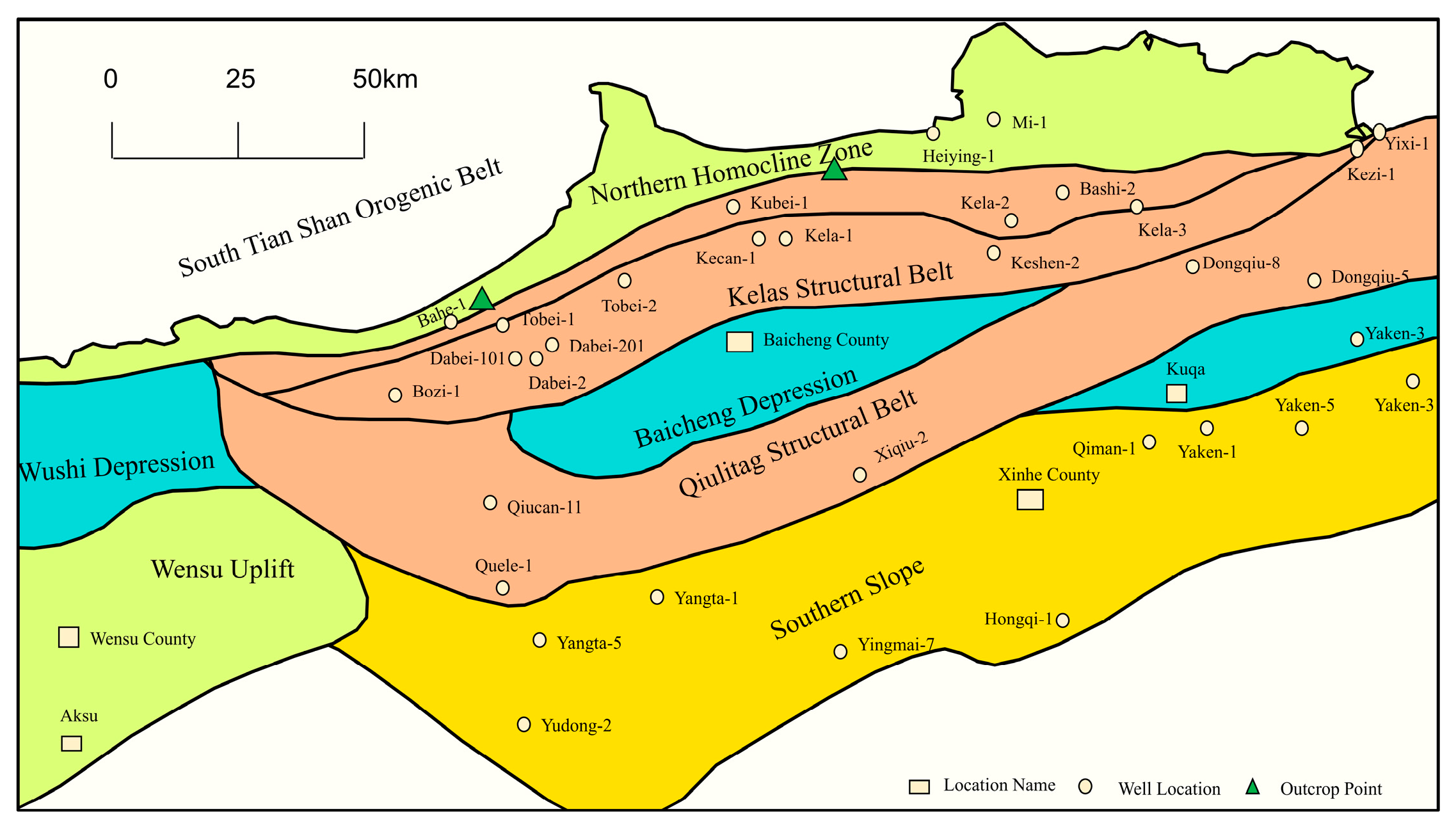

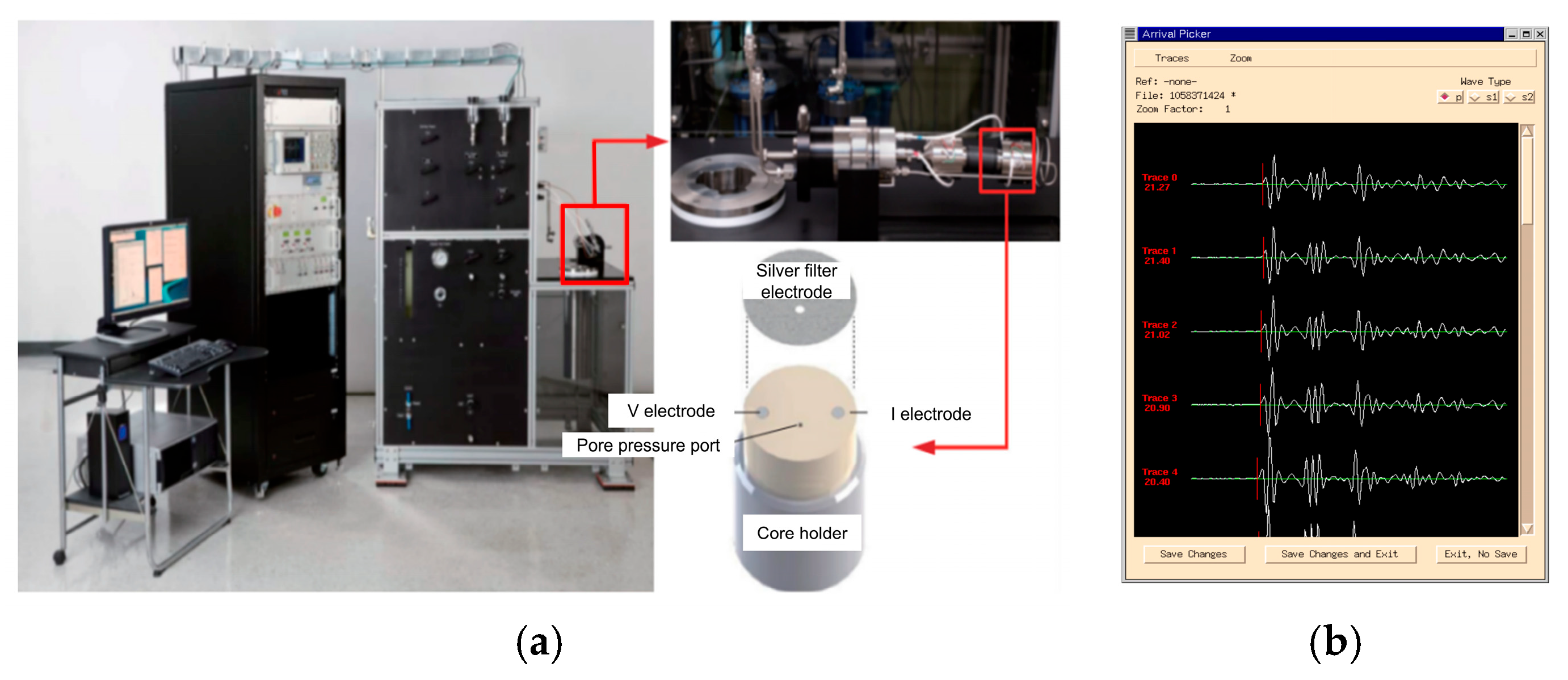
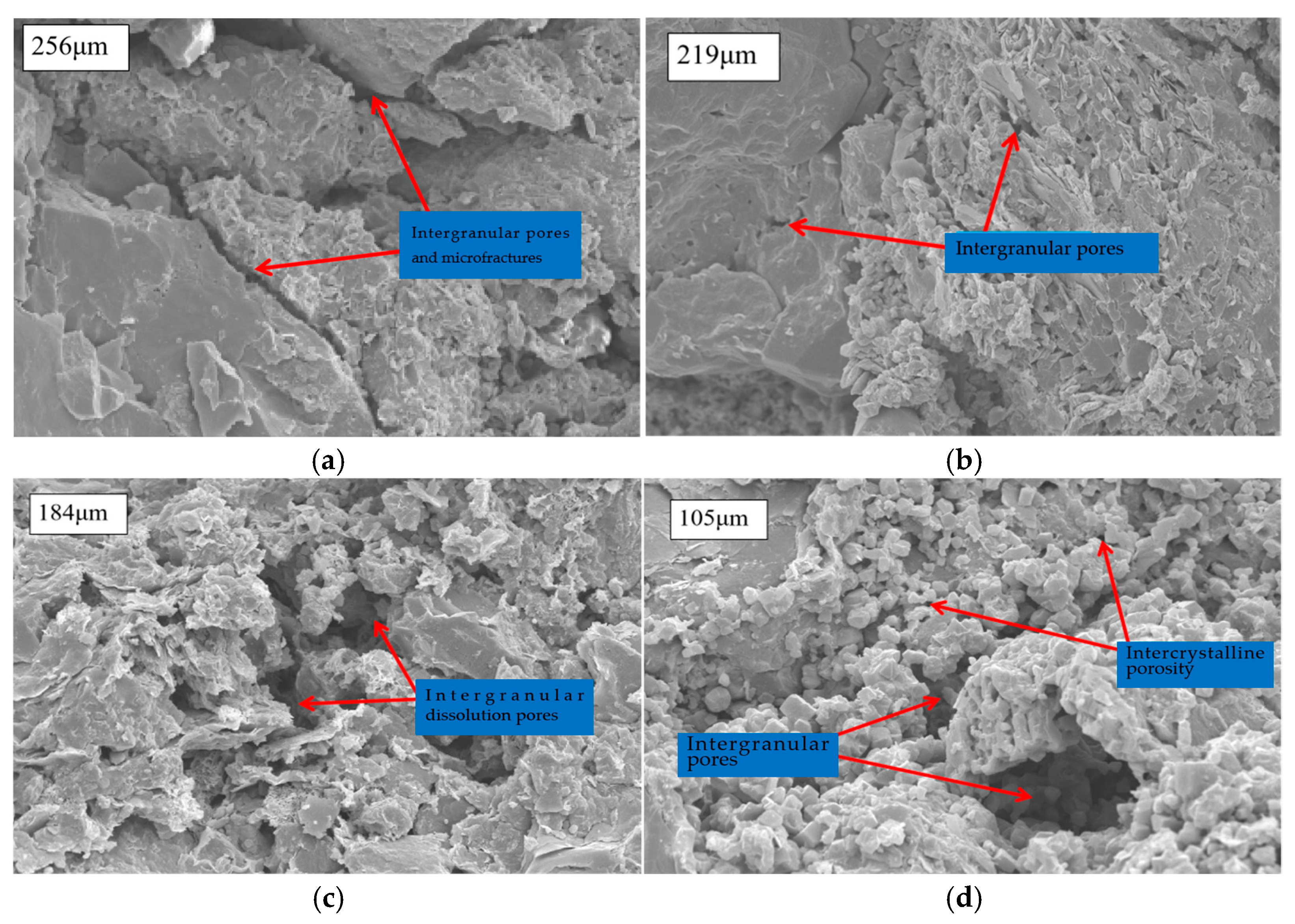
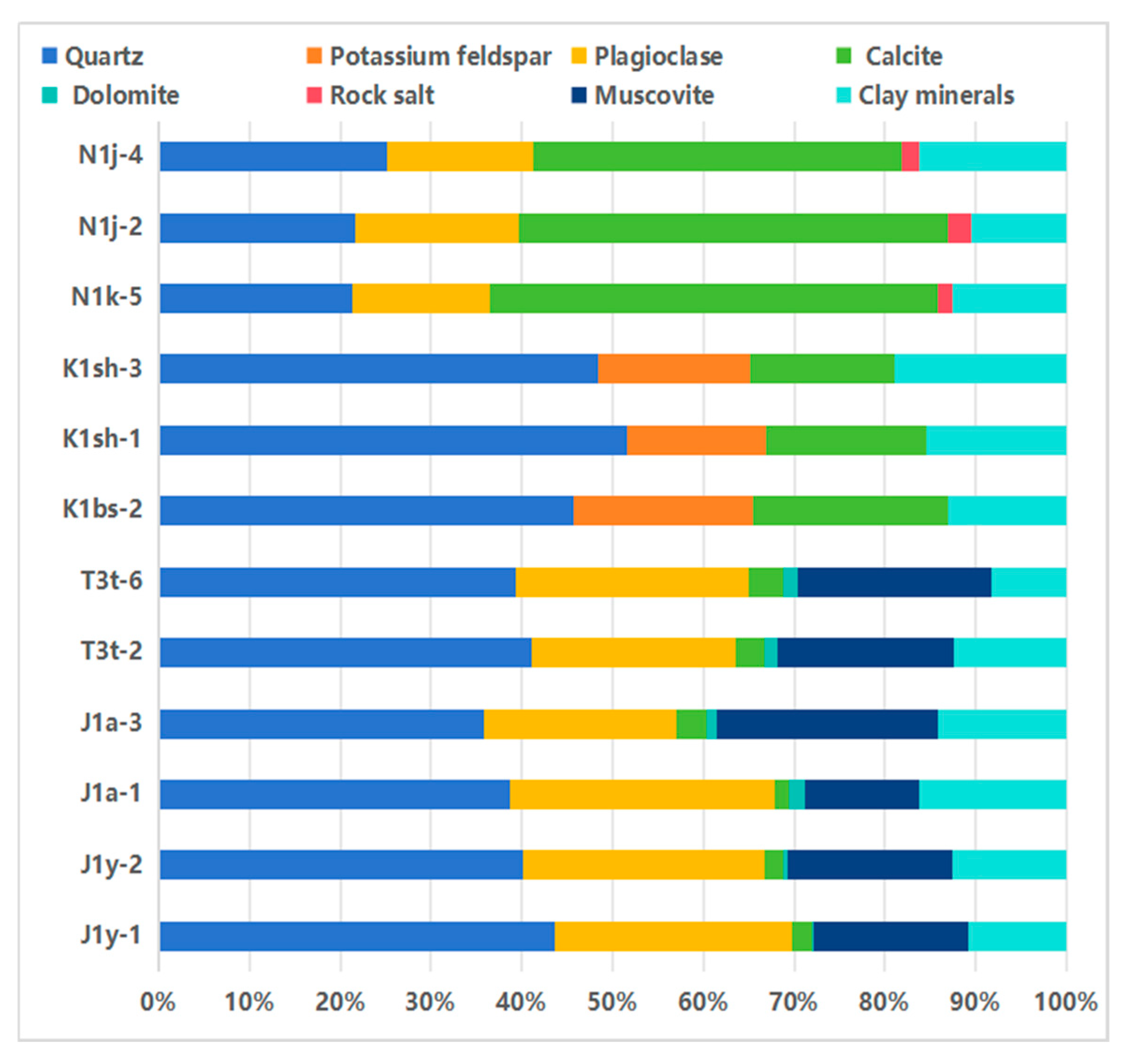

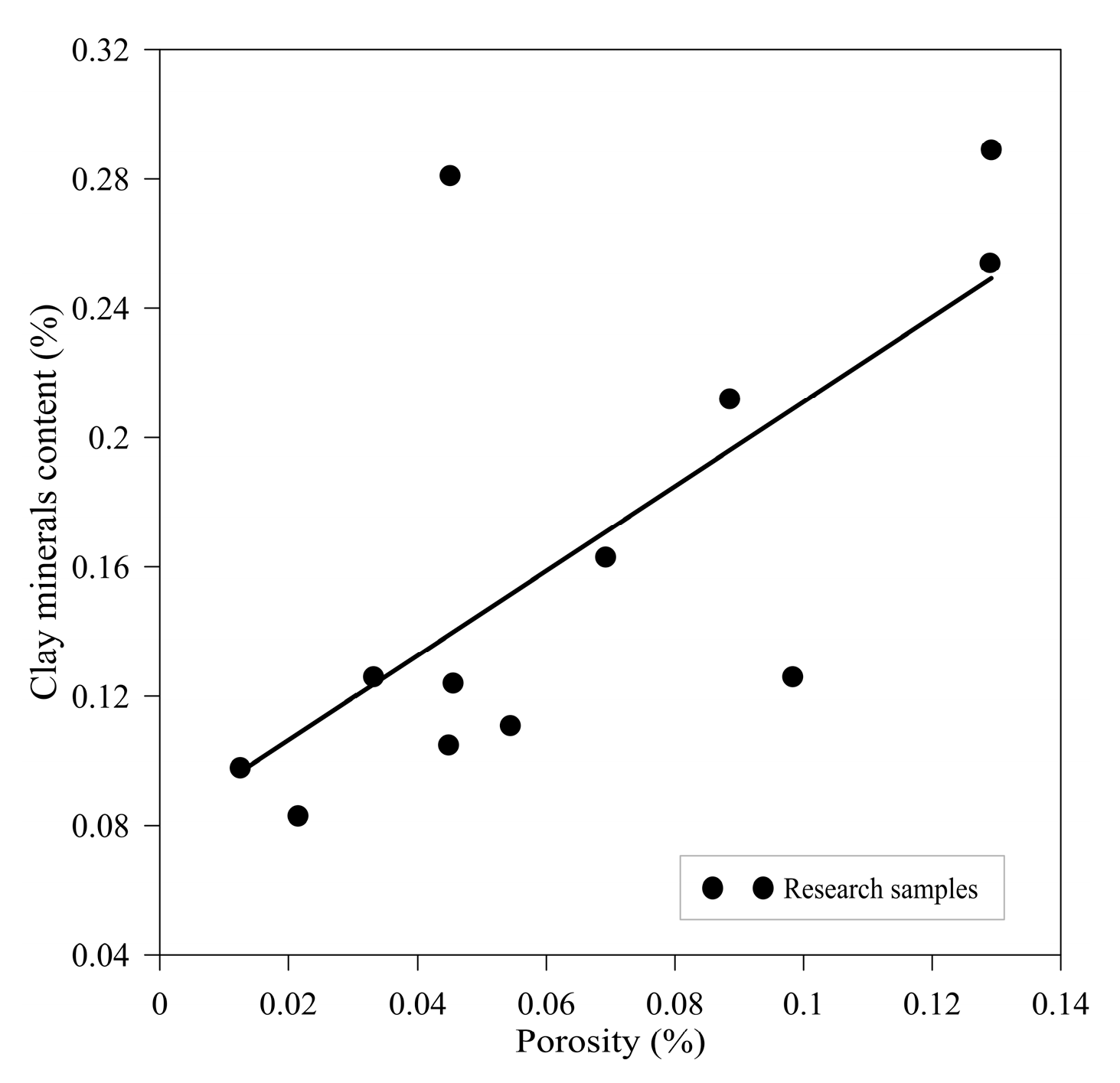

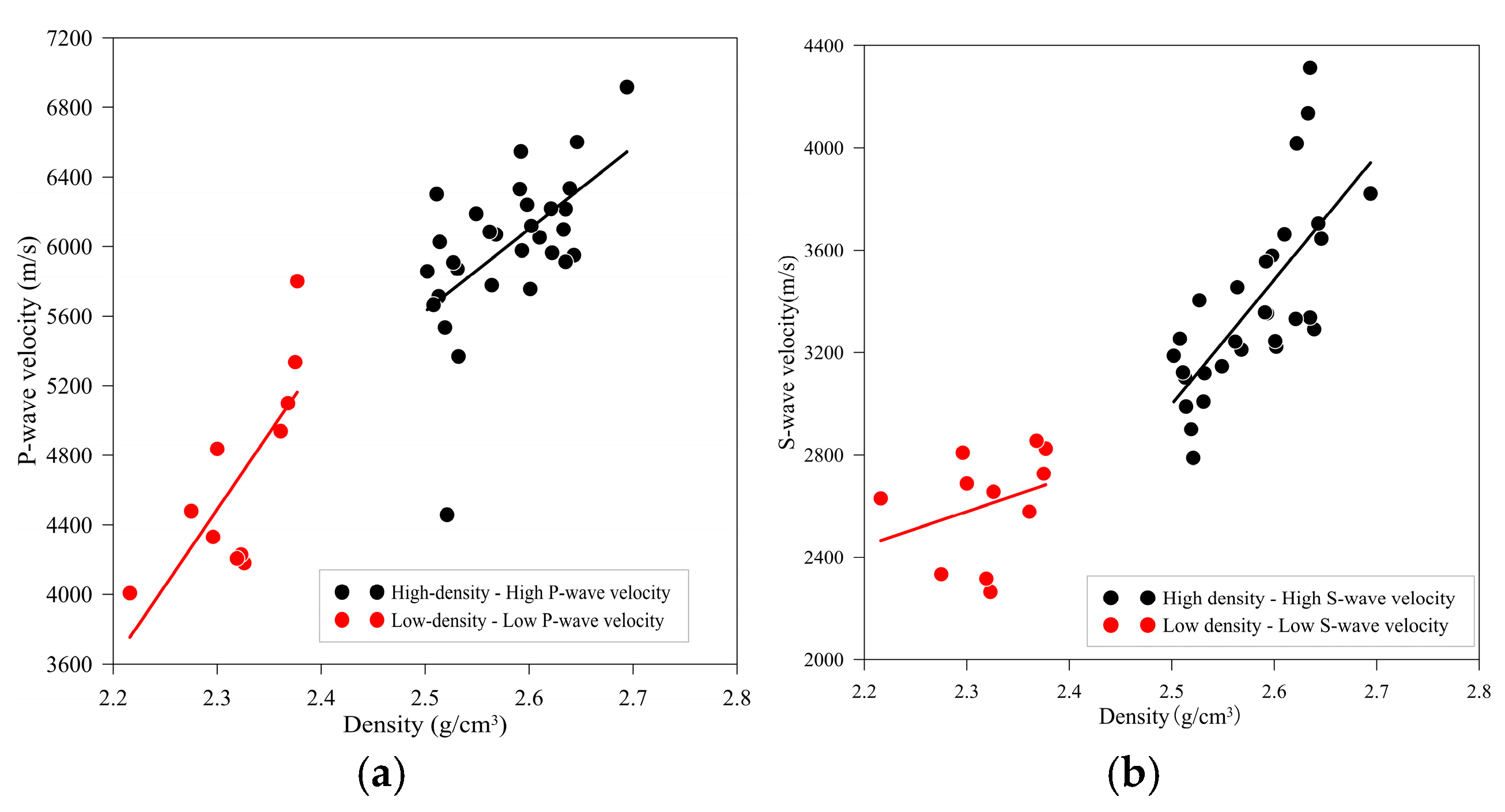

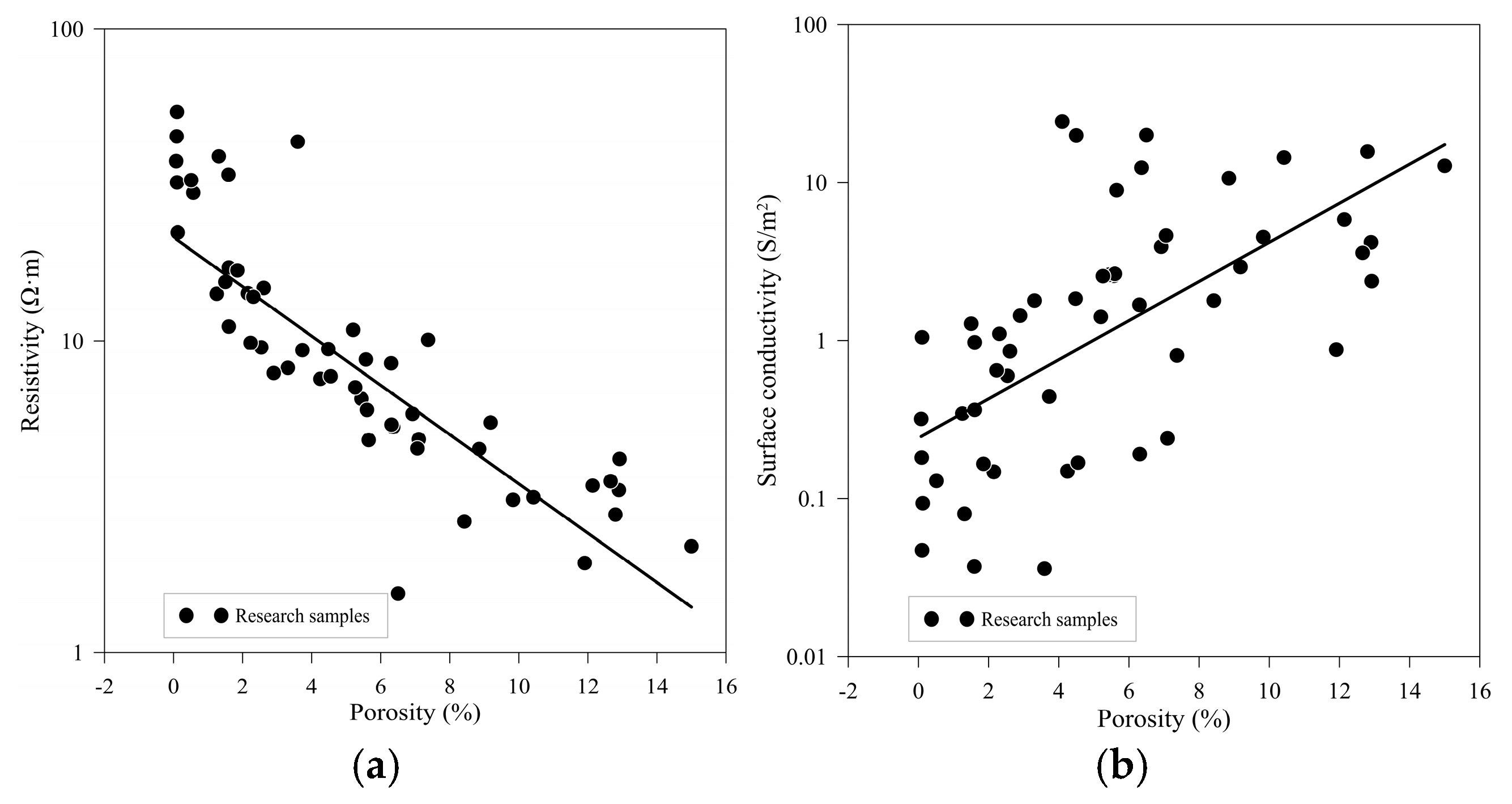
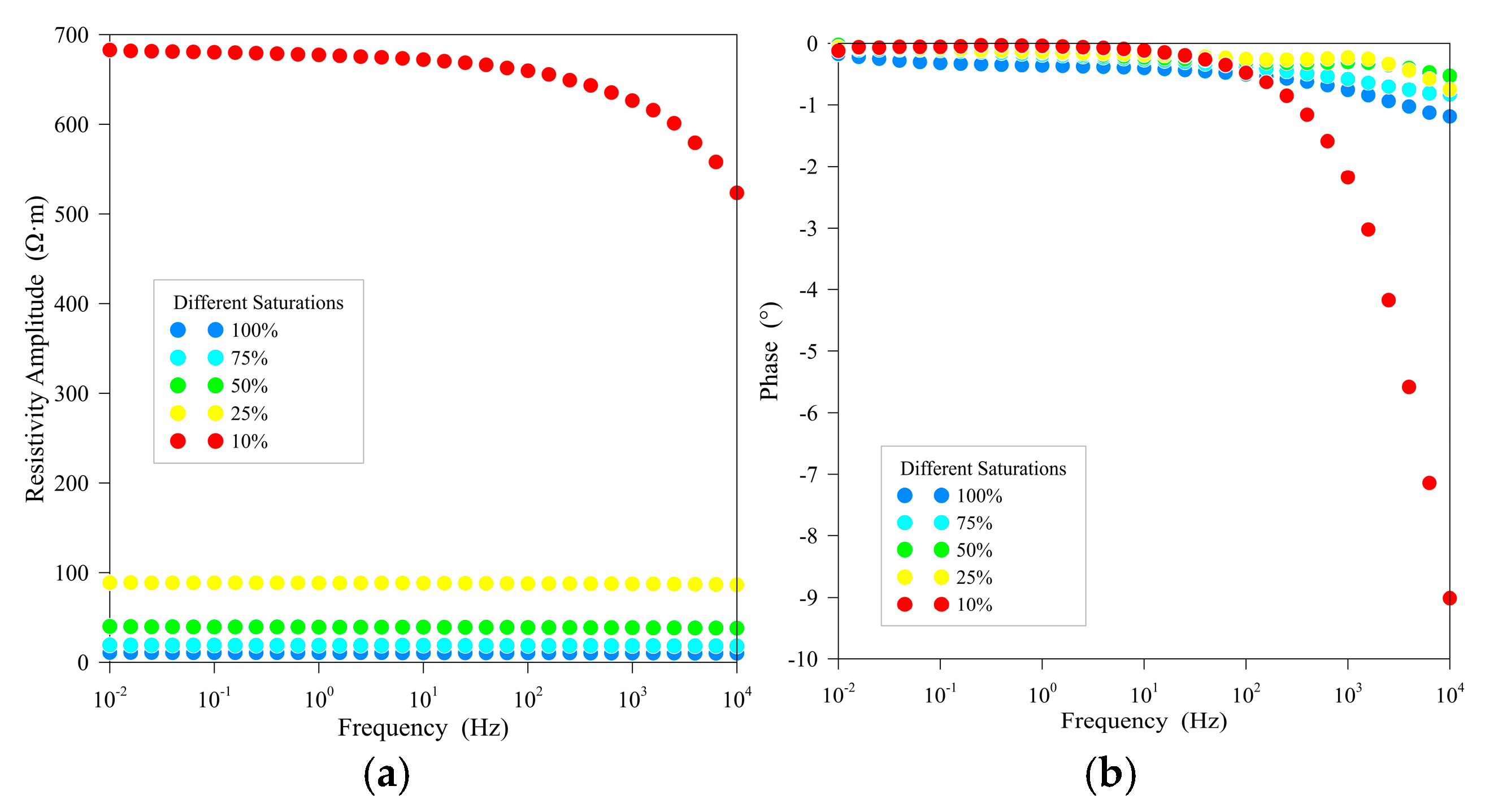
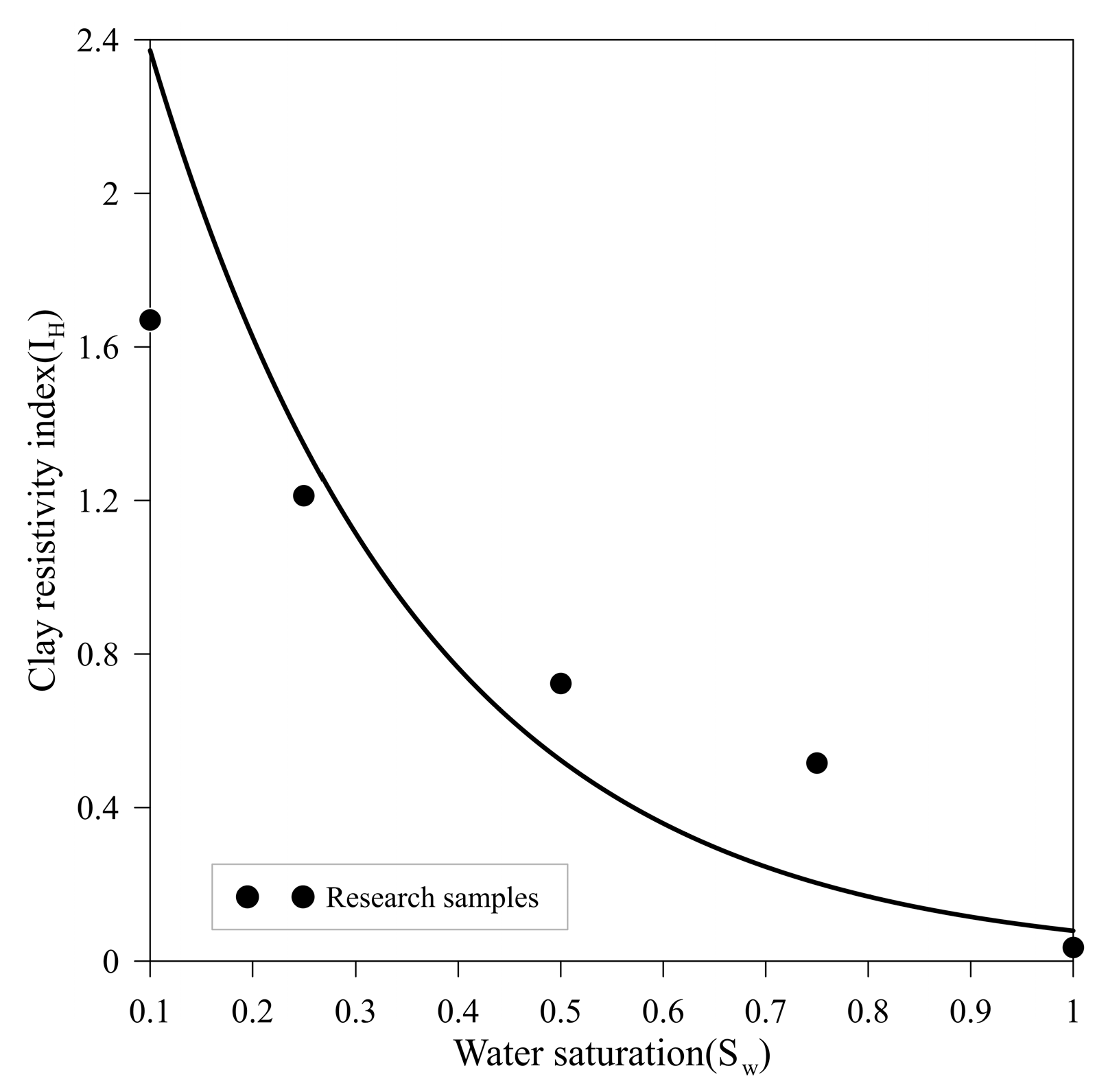

| No. | Sample ID | Porosity | Density (g/cm3) | Resistivity (Ω·m) | Polarizability (%) | Surface Conductivity (S/m2) | P-Wave Velocity (m/s) | S-Wave Velocity (m/s) |
|---|---|---|---|---|---|---|---|---|
| 1 | N1k-1 | 0.1042 | 2.407 | 3.15 | 0.4540 | 0.144 | 4837 | 2688 |
| 2 | N1k-2 | 0.1191 | 2.398 | 1.94 | 0.0170 | 0.009 | 4478 | 2334 |
| 3 | N1k-3 | 0.0842 | 2.543 | 2.63 | 0.0471 | 0.018 | 5529 | 2639 |
| 4 | N1k-4 | 0.1214 | 2.448 | 3.44 | 0.2005 | 0.058 | 4229 | 2265 |
| 5 | N1k-5 | 0.1183 | 2.505 | 3.09 | 0.1397 | 0.045 | 4657 | 2753 |
| 6 | N1j-1 | 0.0557 | 2.576 | 8.72 | 0.2244 | 0.026 | 5534 | 2900 |
| 7 | N1j-2 | 0.1248 | 2.610 | 9.41 | 0.1733 | 0.018 | 5778 | 3456 |
| 8 | N1j-3 | 0.0737 | 2.563 | 10.09 | 0.0812 | 0.008 | 5456 | 2949 |
| 9 | N1j-4 | 0.0692 | 2.560 | 5.83 | 0.2293 | 0.039 | 4893 | 2742 |
| 10 | N1j-5 | 0.0630 | 2.573 | 8.48 | 0.1427 | 0.017 | 5666 | 3254 |
| 11 | K1sh-1 | 0.1290 | 2.429 | 3.32 | 0.1390 | 0.042 | 4330 | 2809 |
| 12 | K1sh-2 | 0.1266 | 2.449 | 3.55 | 0.1273 | 0.036 | 4207 | 2316 |
| 13 | K1sh-3 | 0.1292 | 2.459 | 4.18 | 0.0993 | 0.024 | 4180 | 2656 |
| 14 | K1sh-4 | 0.1500 | 2.371 | 2.19 | 0.2803 | 0.128 | 4007 | 2630 |
| 15 | K1sh-5 | 0.1280 | 2.493 | 2.78 | 0.4358 | 0.157 | 4338 | 2578 |
| 16 | K1bs-1 | 0.0410 | 2.419 | 1.25 | 0.3039 | 0.243 | 5800 | 2824 |
| 17 | K1bs-2 | 0.0450 | 2.414 | 1.47 | 0.2921 | 0.199 | 5099 | 2855 |
| 18 | K1bs-3 | 0.0650 | 2.442 | 1.55 | 0.3102 | 0.200 | 5335 | 2727 |
| 19 | K1bs-4 | 0.0010 | 2.647 | 54.20 | 0.0255 | 0.000 | 6601 | 3646 |
| 20 | K1bs-5 | 0.0029 | 2.640 | 45.27 | 0.0822 | 0.002 | 6335 | 3292 |
| 21 | K1bs-6 | 0.0010 | 2.602 | 32.22 | 0.3375 | 0.010 | 5756 | 3245 |
| 22 | K1b-1 | 0.0160 | 2.609 | 11.12 | 0.1082 | 0.010 | 5978 | 3353 |
| 23 | J1y-1 | 0.0254 | 2.553 | 9.53 | 0.0571 | 0.006 | 5908 | 3404 |
| 24 | J1y-2 | 0.0331 | 2.565 | 8.20 | 0.1469 | 0.018 | 5871 | 3008 |
| 25 | J1y-3 | 0.0373 | 2.551 | 9.34 | 0.0413 | 0.004 | 5713 | 3104 |
| 26 | J1y-4 | 0.0290 | 2.562 | 7.89 | 0.1136 | 0.014 | 5369 | 3120 |
| 27 | J2y-1 | 0.0125 | 2.707 | 14.16 | 0.0489 | 0.003 | 6917 | 3822 |
| 28 | J2y-2 | 0.0223 | 2.572 | 9.86 | 0.0640 | 0.006 | 6189 | 3146 |
| 29 | J1a-1 | 0.0885 | 2.507 | 4.50 | 0.4790 | 0.106 | 5160 | 2877 |
| 30 | J1a-2 | 0.0918 | 2.524 | 5.47 | 0.1602 | 0.029 | 4815 | 2588 |
| 31 | J1a-3 | 0.0544 | 2.570 | 6.52 | 0.1705 | 0.026 | 6027 | 2989 |
| 32 | J1a-4 | 0.0261 | 2.619 | 14.79 | 0.1266 | 0.009 | 6546 | 3556 |
| 33 | J2k-1 | 0.0565 | 2.556 | 4.81 | 0.4301 | 0.089 | 5242 | 3291 |
| 34 | J2k-2 | 0.0636 | 2.562 | 5.29 | 0.6567 | 0.124 | 5121 | 2979 |
| 35 | T3t-1 | 0.1325 | 2.565 | 7.55 | 0.0113 | 0.001 | 4457 | 2789 |
| 36 | T3t-2 | 0.0455 | 2.549 | 7.70 | 0.0130 | 0.002 | 5858 | 3187 |
| 37 | T3t-3 | 0.0057 | 2.641 | 29.86 | 0.0063 | 0.000 | 5913 | 3337 |
| 38 | T3t-4 | 0.0051 | 2.648 | 32.75 | 0.0424 | 0.001 | 5951 | 3703 |
| 39 | T3t-5 | 0.0160 | 2.584 | 17.19 | 0.0626 | 0.004 | 6070 | 3211 |
| 40 | T3t-6 | 0.1215 | 2.584 | 14.20 | 0.0210 | 0.001 | 6084 | 3243 |
| 41 | T3h-1 | 0.1231 | 2.557 | 5.39 | 0.0103 | 0.002 | 6319 | 3388 |
| 42 | T3h-2 | 0.0560 | 2.569 | 6.01 | 0.1593 | 0.026 | 6301 | 3123 |
| 43 | T3h-3 | 0.0710 | 2.529 | 4.83 | 0.0116 | 0.002 | 6163 | 3879 |
| 44 | T3h-4 | 0.0706 | 2.553 | 4.51 | 0.2090 | 0.046 | 6432 | 3359 |
| 45 | T3h-5 | 0.0526 | 2.541 | 7.09 | 0.1817 | 0.026 | 5982 | 3345 |
| 46 | T3h-6 | 0.0520 | 2.551 | 10.85 | 0.1535 | 0.014 | 5992 | 3330 |
| 53 | P2by-1 | 0.0008 | 2.622 | 37.70 | 0.1204 | 0.003 | 6218 | 3332 |
| 54 | P2by-2 | 0.0012 | 2.636 | 22.23 | 0.0208 | 0.001 | 6216 | 4313 |
| 55 | P2by-3 | 0.0131 | 2.636 | 39.04 | 0.0313 | 0.001 | 5965 | 4017 |
| 56 | P2by-4 | 0.0359 | 2.670 | 43.52 | 0.0157 | 0.000 | 6099 | 4136 |
| 63 | C-7 | 0.0150 | 2.625 | 15.45 | 0.1978 | 0.013 | 6053 | 3663 |
| 64 | C-8 | 0.0231 | 2.615 | 13.85 | 0.1527 | 0.011 | 6331 | 3357 |
| 65 | C-9 | 0.0185 | 2.621 | 16.82 | 0.0279 | 0.002 | 6119 | 3222 |
| 66 | C-10 | 0.0159 | 2.614 | 34.12 | 0.0127 | 0.000 | 6239 | 3579 |
| Sample ID | Resistivity (Ω·m) | Polarizability (%) | ||||||||
|---|---|---|---|---|---|---|---|---|---|---|
| 100% | 75% | 50% | 25% | 10% | 100% | 75% | 50% | 25% | 10% | |
| N1k-5 | 4.37 | 5.09 | 7.89 | 8.65 | 36.74 | 0.0509 | 0.0628 | 0.039 | 0.0348 | 0.0425 |
| J1y-1 | 4.19 | 4.81 | 8.68 | 12.08 | 41.77 | 0.0583 | 0.0521 | 0.0363 | 0.0311 | 0.0313 |
| J1y-2 | 7.35 | 10.81 | 30.91 | 115.69 | 352.52 | 0.0356 | 0.0339 | 0.0088 | 0.0192 | 0.0001 |
| T3h-1 | 10.46 | 16.64 | 32.84 | 42.21 | 93.93 | 0.0285 | 0.016 | 0.0207 | 0.0048 | 0.024 |
| T3h-2 | 10.96 | 19.36 | 39.8 | 89.61 | 681.15 | 0.0354 | 0.0184 | 0.0156 | 0.015 | 0.0186 |
| J1a-3 | 10.73 | 19.5 | 32.27 | 102.05 | 1122.18 | 0.0323 | 0.0263 | 0.031 | 0.0066 | 0.02 |
| J1a-4 | 26.87 | 54.94 | 82.09 | 221.48 | 663.57 | 0.0377 | 0.045 | 0.0274 | 0.02 | 0.0114 |
| T3t-1 | 10.13 | 20.14 | 30.32 | 165.47 | 238.01 | 0.0369 | 0.0187 | 0.0148 | 0.0115 | 0.0067 |
| T3t-2 | 10.31 | 21.02 | 46.6 | 93.43 | 3111.05 | 0.0356 | 0.0184 | 0.0258 | 0.0432 | 0.0595 |
| T3t-3 | 51.61 | 107.23 | 396.59 | 655.07 | 1878.87 | 0.0561 | 0.028 | 0.0158 | 0.0165 | 0.0168 |
| T3t-4 | 74.09 | 106.74 | 452.16 | 709.11 | 1202.43 | 0.0405 | 0.0349 | 0.0115 | 0.0233 | 0.0213 |
| T3t-6 | 12.89 | 37.02 | 96.9 | 222.55 | 576.1 | 0.0267 | 0.0172 | 0.0031 | 0.0072 | 0.0065 |
| N1j-2 | 12.72 | 16.08 | 43.74 | 64.09 | 131.94 | 0.0175 | 0.0188 | 0.0141 | 0.02 | 0.0185 |
| N1j-3 | 12.86 | 16.13 | 63.57 | 528.89 | 22,650.86 | 0.016 | 0.0128 | 0.0029 | 0.0209 | 0.0733 |
| K1bs-5 | 57.58 | 345.84 | 909.31 | 1868.37 | 10,677.85 | 0.0373 | 0.0304 | 0.0136 | 0.0583 | 0.0785 |
| K1sh-3 | 4.06 | 6.33 | 11.97 | 97.29 | 5143.8 | 0.0743 | 0.0125 | 0.0199 | 0.0071 | 0.0668 |
| K1sh-5 | 3.67 | 5.28 | 9.59 | 30.63 | 66.56 | 0.0799 | 0.0038 | 0.0217 | 0.0516 | 0.0157 |
| K1b-1 | 7.07 | 34.21 | 121.54 | 1764.39 | 2583.84 | 0.0363 | 0.0447 | 0.0129 | 0.0211 | 0.0126 |
| P2by-4 | 59.95 | 118.71 | 816.85 | 1106.14 | 10,670.4 | 0.0454 | 0.0291 | 0.0409 | 0.0477 | 0.1717 |
| C-9 | 24.27 | 51.69 | 87.38 | 316.02 | 3455.86 | 0.0384 | 0.0207 | 0.0038 | 0.0143 | 0.0632 |
| Sample ID | P-Wave Velocity(m/s) | S-Wave Velocity(m/s) | ||||||||
|---|---|---|---|---|---|---|---|---|---|---|
| 100% | 75% | 50% | 25% | 10% | 100% | 75% | 50% | 25% | 10% | |
| N1k-5 | 4660 | 4651 | 4625 | 4611 | 4531 | 2762 | 2752 | 2734 | 2713 | 2649 |
| J1y-1 | 5926 | 5921 | 5913 | 5858 | 5788 | 3412 | 3406 | 3389 | 3364 | 3344 |
| J1y-2 | 5885 | 5882 | 5862 | 5806 | 5790 | 3015 | 3006 | 2996 | 2973 | 2911 |
| T3h-1 | 6320 | 6315 | 6305 | 6298 | 6232 | 3392 | 3386 | 3366 | 3342 | 3311 |
| T3h-2 | 6312 | 6311 | 6293 | 6236 | 6222 | 3116 | 3115 | 3102 | 3091 | 3038 |
| J1a-3 | 6021 | 6018 | 5990 | 5941 | 5866 | 2982 | 2976 | 2964 | 2928 | 2877 |
| J1a-4 | 6549 | 6546 | 6531 | 6485 | 6440 | 3558 | 3555 | 3544 | 3533 | 3464 |
| T3t-1 | 4451 | 4450 | 4442 | 4433 | 4404 | 2791 | 2786 | 2774 | 2748 | 2721 |
| T3t-2 | 5862 | 5858 | 5851 | 5831 | 5794 | 3181 | 3176 | 3163 | 3141 | 3111 |
| T3t-3 | 5916 | 5913 | 5896 | 5840 | 5799 | 3340 | 3334 | 3324 | 3297 | 3270 |
| T3t-4 | 5951 | 5947 | 5943 | 5891 | 5876 | 3709 | 3707 | 3692 | 3684 | 3666 |
| T3t-6 | 6089 | 6085 | 6065 | 6042 | 6030 | 3240 | 3233 | 3223 | 3188 | 3122 |
| N1j-2 | 5779 | 5769 | 5740 | 5720 | 5708 | 3459 | 3454 | 3437 | 3408 | 3357 |
| N1j-3 | 5458 | 5449 | 5441 | 5428 | 5377 | 2942 | 2939 | 2933 | 2901 | 2869 |
| K1bs-5 | 6337 | 6329 | 6318 | 6268 | 6233 | 3299 | 3291 | 3284 | 3248 | 3233 |
| K1sh-3 | 4182 | 4180 | 4179 | 4141 | 4127 | 2661 | 2652 | 2641 | 2624 | 2575 |
| K1sh-5 | 4338 | 4336 | 4325 | 4283 | 4243 | 2578 | 2573 | 2563 | 2525 | 2459 |
| K1b-1 | 5979 | 5972 | 5950 | 5940 | 5891 | 3349 | 3341 | 3326 | 3308 | 3288 |
| P2by-4 | 6089 | 6082 | 6046 | 5998 | 5967 | 4116 | 4106 | 4101 | 4070 | 4041 |
| C-9 | 6119 | 6114 | 6102 | 6082 | 6004 | 3229 | 3220 | 3204 | 3196 | 3142 |
Disclaimer/Publisher’s Note: The statements, opinions and data contained in all publications are solely those of the individual author(s) and contributor(s) and not of MDPI and/or the editor(s). MDPI and/or the editor(s) disclaim responsibility for any injury to people or property resulting from any ideas, methods, instructions or products referred to in the content. |
© 2025 by the authors. Licensee MDPI, Basel, Switzerland. This article is an open access article distributed under the terms and conditions of the Creative Commons Attribution (CC BY) license (https://creativecommons.org/licenses/by/4.0/).
Share and Cite
Cui, J.; Xiang, K.; Tong, X.; Shi, Y.; Hu, Z.; Yan, L. Analysis and Modeling of Elastic and Electrical Response Characteristics of Tight Sandstone in the Kuqa Foreland Basin of the Tarim Basin. Minerals 2025, 15, 764. https://doi.org/10.3390/min15070764
Cui J, Xiang K, Tong X, Shi Y, Hu Z, Yan L. Analysis and Modeling of Elastic and Electrical Response Characteristics of Tight Sandstone in the Kuqa Foreland Basin of the Tarim Basin. Minerals. 2025; 15(7):764. https://doi.org/10.3390/min15070764
Chicago/Turabian StyleCui, Juanli, Kui Xiang, Xiaolong Tong, Yanling Shi, Zuzhi Hu, and Liangjun Yan. 2025. "Analysis and Modeling of Elastic and Electrical Response Characteristics of Tight Sandstone in the Kuqa Foreland Basin of the Tarim Basin" Minerals 15, no. 7: 764. https://doi.org/10.3390/min15070764
APA StyleCui, J., Xiang, K., Tong, X., Shi, Y., Hu, Z., & Yan, L. (2025). Analysis and Modeling of Elastic and Electrical Response Characteristics of Tight Sandstone in the Kuqa Foreland Basin of the Tarim Basin. Minerals, 15(7), 764. https://doi.org/10.3390/min15070764








